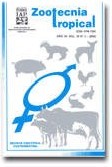
|
Zootecnia Tropical
Instituto Nacional de Investigaciones Agrícolas Venezuela
ISSN: 0798-7269
Vol. 22, No. 2, 2004, pp. 191-200
|
 Bioline Code: zt04012
Bioline Code: zt04012
Full paper language: Spanish
Document type: Research Article
Document available free of charge
|
|
|
Zootecnia Tropical, Vol. 22, No. 2, 2004, pp. 191-200
| es |
Parámetros genéticos para sobrevivencia al nacer en porcinos
Carlos Domínguez, Nelson Martínez y Omar Colmenares
Resumen
Con la finalidad de estimar índices de herencia directos (h2d) y maternos (h2m), correlaciones genéticas entre efectos directos y maternos (rdm), heterosis y tendencias fenotípicas (Tf), genéticas (Tg) y ambientales (Ta), se analizaron 15308 registros de sobrevivencia de lechigadas al nacer, utilizando modelos lineales a través de dos metodologías: cuadrados mínimos (CM) y máxima verosimilitud restringida (REML). El modelo incluyó los efectos fijos: año y época de nacimiento, granja, número de parto, grupo racial de camada, las covariables: lechones nacidos vivos y peso de la camada al nacer, además de los efectos aleatorios de padre para CM y camada (directo) y madre (materno) para REML. Los análisis se realizaron por separado para razas blancas (RB = Large White, LW y Landrace, L) y razas de color (RC = Duroc, D y Hampshire, H). Los promedios no ajustados y ajustados resultaron en 94,53%, 93.54% para RB y 93.53%, 95.65% para RC. Los h2d utilizando CM y REML: 0.010 y 0.010; 0.004 y 0.010; 0.062 y 0.020; no estimable y 0.010 para LW, L, D y H, los h2m y rdm: 0.030 y 0.980; 0.020 y 0.950; 0.040 y 1.000, 0.070 y 1.000. La heterosis resultó estadísticamente no significativa (NS). Las Tg y Ta (P<0.01) corresponden a (0.580 y 0.684 en LW) y (-1.111 y 1.230 en L), las otras tendencias resultaron NS. Se concluye que las variaciones en la sobrevivencia de la población estudiada se deben en mayor proporción al ambiente y poco al efecto de los genes.
Palabras-clave
Índice de herencia, tendencias, correlaciones genéticas, cerdos, sobrevivencia al nacer.
|
| |
| en |
Genetics parameters of survival at birth in pigs
Carlos Domínguez, Nelson Martínez y Omar Colmenares
Abstract
Direct (h2d) and maternal (h2m) heritabilities, genetic correlation between direct and maternal effects (rdm), heterosis, phenotypic (Tf), genetic (Tg) and environmental (Ta) annual trends, were estimated using 15308 records of litter survival at birth (LSB), with two methodologies: Least Square (LS) and Restricted Maximum Likelihood (REML). The model included year and season of birth, farm, number of calving, litter breed group as fixed effects, number of piglets born alive and litter weight at birth as covariates. In addition, for LS sire, and for REML animal (direct) and dam (maternal) effects were included as random effects. The analyses were separated for white breeds (WB; Large White =LW and Landrace =L) and for color breeds (CB; Duroc = D and Hampshire = H). The adjusted and non-adjusted LSB averages were 94.53 and 93.54% for CB and 93.53 and 95.65% for WB. Estimates of h2d from LS and REML were 0.010, 0.010; 0.004, 0.010; 0.062, 0,020 and non-estimable, 0.010 for LW, L, D, and H, respectively. Estimates of h2m and rdm were 0.010, 0.98; 0.020, 0.95; 0.040, 1.000; and 0.07, 1.000 for LW, L, D, and H, respectively. There was not statistical evidence of heterosis for LSB. The Tg and Ta were 0.580 and 0.684 for LW, -1.11 and 1.230 for L, and were the only different from zero (P<0.01). The low estimates of heritabilities indicate that genetic effects are of little importance in comparison with the environmental effects for litter survival at birth in this swine population.
Keywords
Litter Survival at birth, heritability, genetic correlation, swine, annual trends.
|
| |
© Copyright 2004 - Zootecnia Tropical.
Alternative site location: http://www.sian.inia.gob.ve/repositorio/revistas_ci/ZootecniaTropical/ztindice.htm
|
|
